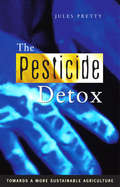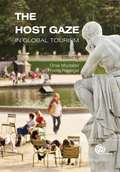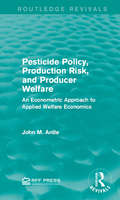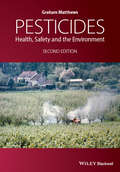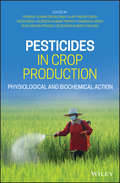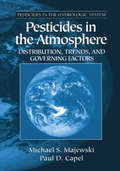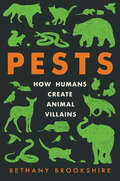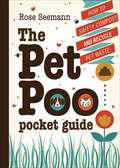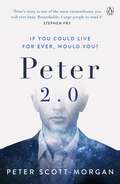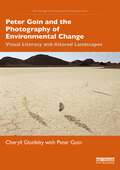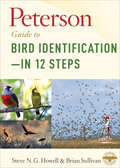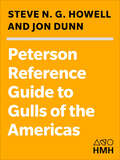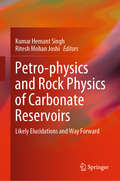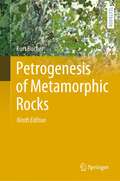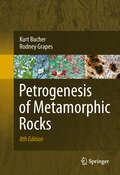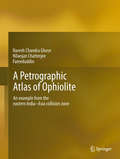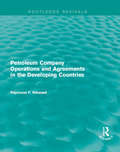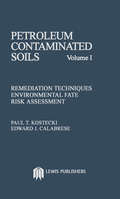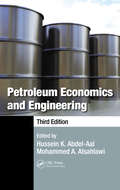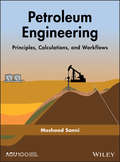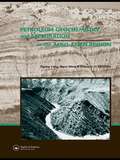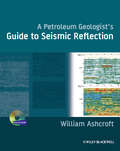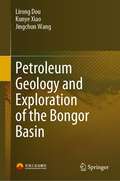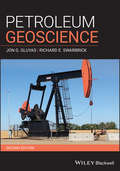- Table View
- List View
The Pesticide Detox: Towards a More Sustainable Agriculture
by Jules PrettySince the 1960s, the world's population has more than doubled and agricultural production per person has increased by a third. Yet this growth in production has masked enormous hidden costs arising from widespread pesticide use - massive ecological damage and high incidences of farmer poisoning and chronic health effects. Whereas once the risks involved with pesticide use were judged to be outweighed by the potential benefits, increasingly the external costs of pesticides, to environments and human health, are being seen as unacceptable. In response to this trend, recent years have seen millions of farmers in communities around the world reduce their use of harmful pesticides and develop cheaper and safer alternatives. The Pesticide Detox explores the potential for the phasing-out of hazardous pesticides and the phasing-in of cost effective alternatives already available on the market. This book makes clear that it is time to start the pesticide detox and to move towards a more sustainable agriculture.
Pesticide Encyclopedia
by Vasant Gowariker V N Krishnamurthy Kalyani Paranjape Sudha GowarikerIn today's world, food security is an important issue. Food shortages push prices up, impacting upon the health and well-being of hundreds of millions of rural poor across the globe. One way to increase food security is to decrease the amount of yield lost to pests. The Pesticide Encyclopedia provides a comprehensive overview of the fight against pests, covering chemical pesticides, biocontrol agents and biopesticides. It also covers interrelated topics such as pesticide toxicity, legislation and regulation, handling, storage and safety aspects, IPM techniques, resistance management, interaction of pesticides with soil and the environment. An important reference for policy makers, advisers and students and researchers of crop science, this book also includes useful notes on commonly known plant diseases and pests.
Pesticide Policy, Production Risk, and Producer Welfare: An Econometric Approach to Applied Welfare Economics (Routledge Revivals)
by John M. AntleThe use of pesticides to control agricultural pests both benefits farm production and imposes health and environmental costs on producers and society. This title, first published in 1988, includes an application of the author’s methodology to tomato production, in which Antle illuminates the roles that alternative methods of pest management play in producer welfare. He also develops a more general empirical framework for studying producer welfare under uncertainty – a framework in which production risk, sequential decision making, and attitudes toward risk are integrated. This title will be of interest to students of environmental studies.
Pesticides
by Graham MatthewsCrop protection continues to be an important component of modern farming to maintain food production to feed an expanding human population, but considerable changes have occurred in the regulation of pesticides in Europe in the last decade. The aim has been to reduce their impact on people and the environment. This has resulted in a major reduction in the number of chemicals approved for application on crops. In other parts of the world, a continuing expansion in the growing of genetically modified crops has also changed the pattern of pesticide use. In this second edition, Graham Matthews, updates how pesticides are registered and applied and the techniques used to mitigate their effects in the environment. Information on operator safety, protection of workers in crops treated with pesticides and spray drift affecting those who live in farming areas is also discussed. By bringing together the most recent research on pesticides in a single volume, this book provides a vital up to date resource for agricultural scientists, agronomists, plant scientists, plant pathologists, entomologists, environmental scientists, public health personnel, toxicologists and others working in the agrochemical industry and governments. It should assist development of improvements in harmonising regulation of pesticides in countries with limited resources for registration of pesticides.
Pesticides in Crop Production: Physiological and Biochemical Action
by Prabhat Kumar SrivastavaA guide to the diversity of pesticides used in modern agricultural practices, and the relevant social and environmental issues Pesticides in Crop Production offers an important resource that explores pesticide action in plants; pesticide metabolism in soil microbes, plants and animals; bioaccumulation of pesticides and sensitiveness of microbiome towards pesticides. The authors explore pesticide risk assessment, the development of pesticide resistance in pests, microbial remediation of pesticide intoxicated legumes and pesticide toxicity amelioration in plants by plant hormones. The authors include information on eco-friendly pest management. They review the impact of pesticides on soil microorganism, crops and other plants along with the impact on other organisms like aquatic fauna and terrestrial animals including human beings. The book also contains an analysis of pesticide by GC-MS/MS (Gas Chromatography tandem Mass Spectrometry) a reliable method for the quantification and confirmation of multiclass pesticide residues. This important book: Offers a comprehensive guide to the use of the diversity of pesticides and the pertinent social and environmental issues Explores the impact of pesticides from morphological, anatomical, physiological and biochemical perspectives Shows how pesticides affects soil microorganisms, crops and other plants along with the impact on other organisms like aquatic fauna and animals Critically examines whether chemical pesticides are boon or bane and whether they can be replaced by environmental friendly pesticides Written for students, researchers and professionals in agriculture, botany, entomology and biotechnology, Pesticides in Crop Production examines the effects of chemical pesticides and the feasibility of using bio-pesticides.
Pesticides in the Atmosphere: Distribution, Trends, and Governing Factors
by Michael S. MajewskiMost people know about the presence and health effects of pesticide residues in the water they drink. However, they may not realize the impact of atmospheric transportation and deposition of pesticides on water quality. Scientific studies of pesticides in various atmospheric matrices (air, rain, snow, aerosols, and fog) provide some of the answers.
Pests: How Humans Create Animal Villains
by Bethany BrookshireAn engrossing and revealing study of why we deem certain animals “pests” and others not—from cats to rats, elephants to pigeons—and what this tells us about our own perceptions, beliefs, and actions, as well as our place in the natural worldA squirrel in the garden. A rat in the wall. A pigeon on the street. Humans have spent so much of our history drawing a hard line between human spaces and wild places. When animals pop up where we don’t expect or want them, we respond with fear, rage, or simple annoyance. It’s no longer an animal. It’s a pest.At the intersection of science, history, and narrative journalism, Pests is not a simple call to look closer at our urban ecosystem. It’s not a natural history of the animals we hate. Instead, this book is about us. It’s about what calling an animal a pest says about people, how we live, and what we want. It’s a story about human nature, and how we categorize the animals in our midst, including bears and coyotes, sparrows and snakes. Pet or pest? In many cases, it’s entirely a question of perspective.Bethany Brookshire’s deeply researched and entirely entertaining book will show readers what there is to venerate in vermin, and help them appreciate how these animals have clawed their way to success as we did everything we could to ensure their failure. In the process, we will learn how the pests that annoy us tell us far more about humanity than they do about the animals themselves.
The Pet Poo Pocket Guide: How to Safely Compost and Recycle Pet Waste
by Rose SeemannEighty-three million dogs and ninety-six million cats call the United States home. Dogs alone produce enough waste to fill more than 1,091 football fields 1 foot deep in a single year. Add billions of plastic pick-up bags to the mix and season well with tons of litter box waste. Scoop a hefty portion into local landfills and seal it tightly to ensure optimal methane production. Clearly, this is a recipe for disaster.Dog and cat owners who trash their pets' offerings daily are in denial about how much waste is produced and what happens to it. Those who want to make the responsible choice often turn to the internet, only to find misleading, confusing, and contradictory information. The Pet Poo Pocket Guide will help you reduce your pet's environmental paw print with: Best practices for cycling pet waste back to nature Suggestions on how to tailor your approach based on location, situation, weather, needs, or available time Instructions for using your composted pet waste safely to enrich your soil and nourish ornamental plantsWith recycling tactics clearly indicated as "easy," "moderate," or "demanding," The Pet Poo Pocket Guide offers something for everyone. This no-nonsense guide is a must-read for any pet owner who is concerned about the environmental impact of their best friend, and is seeking a safe and practical solution.Rose Seemann is the owner and operator of EnviroWagg, a company dedicated to collecting and composting canine waste into safe, nutrient-rich garden soil.
Peter 2.0: The Human Cyborg
by Peter Scott-MorganThe incredible book behind the primetime Channel 4 documentary, Peter: The Human Cyborg'A remarkable account of what it means to be human and what technology can really achieve' Sunday Telegraph'Peter's story is one of the most extraordinary you will ever hear. I urge people to read it' Stephen Fry'A remarkable story . . . you're left desperate to take nothing for granted' Radio Times __________ Peter, a brilliant scientist, is told that he will lose everything he loves. His husband. His family. His friends. His ability to travel the world. All will be gone. But Peter will not give up. He vows that this will not be the end and instead seeks a completely new beginning . . . Peter has Motor Neurone Disease, a condition universally considered by doctors to be terminal. He is told it will destroy his nerve cells and that within about two years, it will take his life too. But, face-to-face with death, he decides there is another way. Using his background in science and technology, he navigates a new path, one that will enable him not just to survive, but to thrive. This is the astonishing true story about Peter Scott-Morgan: the first person to combine his very humanity with artificial intelligence and robotics to become a full Cyborg. His discovery means that his terminal diagnosis is negotiable, something that will rewrite the future.And change the world. By embracing love, life and hope rather than fear, tragedy and despair, he will become Peter 2.0. __________'Compelling . . . Scott-Morgan is a true one-off. It is in the telling of the love story, rather than the technical details of becoming a cyborg, that this book succeeds' The Times 'What's striking is Peter's constant optimism, bravery and his ability to find radical answers to problems that have confounded Britain's brightest minds' Daily Telegraph 'A soaring love story' Financial Times 'Fascinating and extremely moving' Sun
Peter Goin and the Photography of Environmental Change: Visual Literacy and Altered Landscapes (Routledge Environmental Humanities)
by Peter Goin Cheryll GlotfeltyPeter Goin and the Photography of Environmental Change narrates the forty-year quest of award-winning and internationally exhibited contemporary photographer Peter Goin to document human-altered landscapes across America and beyond. It is a collaborative work between an artist and a literary critic, a retrospective of an accomplished environmental photographer, and an innovative education in visual reading. Enduring howling wind, pounding rain, and blistering sun, Goin bears witness to radioactive landscapes, abandoned mines, simulated swamps, rechanneled rivers, controlled burns, overgrown ruins, industrialized agriculture, shrinking reservoirs, feral spaces in the city, architected wilderness, sacred wastelands, contested borderlands, and more. Based on more than seventy hours of taped interviews with the artist spanning over a decade, trailblazing ecocritic Cheryll Glotfelty narrates the arc of Goin's career, sharing excerpts from their conversations that reveal his brilliant mind and piquant personality while situating his work within the broader context of environmental thinkers. This beautifully illustrated volume, with 200 images in color and black-and-white showcasing Goin’s work, will be a fascinating and insightful read for upper-level students, academics, and researchers in photography, environmental history and culture, landscape studies, and environmental humanities.
Peterson Guide To Bird Identification—in 12 Steps (The\crossover Ser.)
by N. G. Howell Brian L. Sullivan&“The birding equivalent of having Albert Einstein and Stephen Hawking teach you how to count, add, subtract, multiply, do long division, comprehend quantum mechanics, plus balance your checkbook. Bird watchers at every skill level will garner insights from this book.&” — Pete Dunne, author of Birds of Prey &“Identifying birds is a science and an art, involving far more than merely memorizing field marks. Steve Howell and Brian Sullivan are leading masters of this craft, and they share a wealth of inside knowledge in this gem of a book. If you're a birder at any level of experience, from beginner to expert, read this book from cover to cover and I guarantee it will improve your skills in the field.&” — Kenn Kaufman, author of the Kaufman Field Guide to Advanced Birding &“ . . . if you are going to have a book-based conversation with bird experts about identification, Howell and Sullivan are going to be at the top of the list. . . . [The Peterson Guide to Bird Identification—In 12 Steps] is a highly opinionated book reflecting the approach and thoughts of the authors. Which is exactly what makes it a book that all birders should read, consult, and maybe even, like me, read again.&” — Donna Schulman, 10,000 Birds.com &“This book is friendly, non-intimidating, and even humorous. New birders can acquire some basics from this handy little book, and experienced birders can pick up some vital pointers, especially useful when helping the uninitiated. . . . Basically, there is something in this short book for every birder, and the 152 pages present many opportunities for all birders to pick out and explore what that &‘something&’ may be.&” —Paul J. Baicich and Wayne Petersen, Birding Community E-bulletin —
Peterson Reference Guides To Gulls of The Americas (Peterson Reference Guides)
by N. G. Howell Jon DunnThis ambitious volume covers the 36 species of gulls that occur in North and South America, with detailed information to help you identify these fascinating but challenging birds in their many and varied plumages. With 1,160 carefully chosen color photographs, this new reference guide, written by two of North America's top gull experts, is the definitive new work on gulls of the Americas.Peterson Reference Guides offer authoritative, comprehensive information, including detailed text, maps, and superior illustrations. Written by expert authors, the guides are an unparalleled resource for understanding specific groups of animals.
Peterson's First Guide to Seashores
by John KricherPeterson First Guides are the first books the beginning naturalist needs. Simplified versions of the famous Peterson Field Guides, the First Guides focus on the animals, plants, and other things you are most likely to see. They make it easy to get started in the field-and easy to graduate to the full-fledged Peterson Guides.
Petro-physics and Rock Physics of Carbonate Reservoirs: Likely Elucidations and Way Forward
by Kumar Hemant Singh Ritesh Mohan JoshiThis book presents selected articles from the workshop on "Challenges in Petrophysical Evaluation and Rock Physics Modeling of Carbonate Reservoirs" held at IIT Bombay in November 2017. The articles included explore the challenges associated with using well-log data, core data analysis, and their integration in the qualitative and quantitative assessment of petrophysical and elastic properties in carbonate reservoirs. The book also discusses the recent trends and advances in the area of research and development of carbonate reservoir characterization, both in industry and academia. Further, it addresses the challenging concept of porosity portioning, which has huge implications for exploration and development success in these complex reservoirs, enabling readers to understand the varying orders of deposition and diagenesis and also to model the flow and elastic properties.
Petrogenesis of Metamorphic Rocks (Springer Textbooks in Earth Sciences, Geography and Environment)
by Kurt BucherThis new edition of the classic textbook presents a large number of diagrams showing the stability relations among minerals and groups of minerals found in metamorphic rocks. The diagrams help to determine the pressure and temperature conditions under which a given set of metamorphic rocks may have formed. Other parameters that control metamorphic mineral assemblages are also discussed and pitfalls resulting from simplifications and generalizations are highlighted. The book discusses the most common metamorphic rock types, their nomenclature, structure and graphical representation of their mineral assemblages. Part I defines basic principles of metamorphism, introduces metamorphic processes, geologic thermometry and barometry and defines metamorphic grade. Part II presents in a systematic way mineralogical changes and assemblages found in the most common types of metamorphic rocks. The computation of diagrams is based on recent advances in quantitative petrology and geochemistry. An extensive bibliography, including the key contributions and classic papers in the field, make it an invaluable source book for graduate students and professional geologists.
Petrogenesis of Metamorphic Rocks
by Rodney Grapes Kurt BucherPetrogenesis of Metamorphic Rocks presents a large number of diagrams showing the stability relations among minerals and groups of minerals found in metamorphic rocks. The diagrams help to determine the pressure and temperature conditions under which a given set of metamorphic rocks may have formed. Other parameters that control metamorphic mineral assemblages are also discussed and pitfalls resulting from simplifications and generalizations are highlighted. The book discusses the most common metamorphic rock types, their nomenclature, structure and graphical representation of their mineral assemblages. Part I defines basic principles of metamorphism, introduces metamorphic processes, geologic thermometry and barometry and defines metamorphic grade. Part II presents in a systematic way mineralogical changes and assemblages found in the most common types of metamorphic rocks. The computation of diagrams is based on recent advances in quantitative petrology and geochemistry. An extensive bibliography, including the key contributions and classic papers in the field, make it an invaluable source book for graduate students and professional geologists.
A Petrographic Atlas of Ophiolite: An example from the eastern India-Asia collision zone
by Naresh Chandra Ghose Nilanjan Chatterjee FareeduddinThe book is a thoughtful discussion with scientists studying convergent plate boundaries such as the well-known, active India-Eurasia collision zone. It provides a comprehensive collection of petrographic images of ophiolitic rocks exhumed from oceanic lithosphere and mantle at the India-Asia plate boundary. Ophiolite is exposed in the northwestern Himalayas, eastern Indian plate margin and Andaman-Nicobar Islands. At the eastern margin, it occurs in a narrow strip comprising mantle peridotite tectonite, cummulate peridotite-gabbro-plagiogranite-anorthosite, mafic dyke, volcanics and oceanic sediments. Low temperature/high pressure rocks including blueschists and eclogites were extensively studied recently. Ophiolite derived sediments and podiform chromites will also be discussed to provide complete details. Supplemental maps, geological sections, field sketches and photographs will explain the structure, stratigraphy, ore mineralization, and metamorphic history.
Petroleum Company Operations and Agreements in the Developing Countries (Routledge Revivals)
by Raymond F. MikesellOriginally published in 1984, this study focuses on petroleum agreements between non-OPEC LDCs with oil-importing LDCs and how issues such as high oil prices affect each country. The information presented in this study was drawn from interviews with petroleum officials in petroleum companies, petroleum ministries and unpublished documents such as contracts and focussing on case studies of countries such as Peru, Guatemala and Malaysia. This title will be of interest to students of environmental studies and economics.
Petroleum Contaminated Soils, Volume I: Remediation Techniques, Environmental Fate, and Risk Assessment
by Paul T. KosteckiThese three volumes provide valuable information to help bring rational and scientifically feasible solutions to petroleum contaminated soils. State-of-the-art information on both technical and regulatory issues is covered, including environmental fate, health effects, risk assessment and remedial alternatives. They show why petroleum contaminated soils are a problem - and propose solutions for that problem. These books are an excellent reference for regulatory personnel and environmental consultants at all levels.
Petroleum Economics and Engineering
by Hussein K. Abdel-Aal Mohammed A. AlsahlawiThis book explains how to apply economic analysis to the evaluation of engineering challenges in the petroleum industry. Discussion progresses from an introduction to the industry, through principles and techniques of engineering economics, to the application of economic methods. Packed with real-world examples and case studies demonstrating how to
Petroleum Engineering: Principles, Calculations And Workflows (Geophysical Monograph Series #237)
by Moshood SanniA comprehensive and practical guide to methods for solving complex petroleum engineering problems Petroleum engineering is guided by overarching scientific and mathematical principles, but there is sometimes a gap between theoretical knowledge and practical application. Petroleum Engineering: Principles, Calculations, and Workflows presents methods for solving a wide range of real-world petroleum engineering problems. Each chapter deals with a specific issue, and includes formulae that help explain primary principles of the problem before providing an easy to follow, practical application. Volume highlights include: A robust, integrated approach to solving inverse problems In-depth exploration of workflows with model and parameter validation Simple approaches to solving complex mathematical problems Complex calculations that can be easily implemented with simple methods Overview of key approaches required for software and application development Formulae and model guidance for diagnosis, initial modeling of parameters, and simulation and regression Petroleum Engineering: Principles, Calculations, and Workflows is a valuable and practical resource to a wide community of geoscientists, earth scientists, exploration geologists, and engineers. This accessible guide is also well-suited for graduate and postgraduate students, consultants, software developers, and professionals as an authoritative reference for day-to-day petroleum engineering problem solving.
Petroleum Geochemistry and Exploration in the Afro-Asian Region: Proceedings of the 6th AAAPG International Conference, Beijing, China, 12-14 October 2004
by Digang Liang Darui Wang Zhenxi LiPetroleum Geochemistry and Exploration in the Afro-Asian Region includes 29 papers presented at the 6th International Conference on Petroleum Geochemistry and Exploration in the Afro-Asian Region.Petroleum geochemistry has played a crucial role in determining effective source rocks, classifying petroleum systems and delineating the geneses of conve
A Petroleum Geologist's Guide to Seismic Reflection
by William AshcroftThis book is written for advanced earth science students, geologists, petroleum engineers and others who want to get quickly 'up to speed' on the interpretation of reflection seismic data. It is a development of material given to students on the MSc course in Petroleum Geology at Aberdeen University and takes the form of a course manual rather than a systematic textbook. It can be used as a self-contained course for individual study, or as the basis for a class programme.The book clarifies those aspects of the subject that students tend to find difficult, and provides insights through practical tutorials which aim to reinforce and deepen understanding of key topics and provide the reader with a measure of feedback on progress. Some tutorials may only involve drawing simple diagrams, but many are computer-aided (PC based) with graphics output to give insight into key steps in seismic data processing or into the seismic response of some common geological scenarios. Part I of the book covers basic ideas and it ends with two tutorials in 2-D structural interpretation. Part II concentrates on the current seismic reflection contribution to reservoir studies, based on 3-D data.
Petroleum Geology and Exploration of the Bongor Basin
by Lirong Dou Kunye Xiao Jingchun WangThis book offers case study of the tridimensional exploration in whole exploration cycle with comprehensive and systematic geological and geophysical studies in the Bongor Basin. Focused on the typical intensively inversed rift basin—the Bongor Basin in Chad, this book establishes petroleum geology model, accumulation model of the typical intensively inversed rift basin and ensemble exploration techniques by studying comprehensively through the lens of structural geology, petrology, geochronology, sedimentology, paleontology, petroleum geochemistry, petroleum geology, and hydrocarbon accumulation dynamics studies on both granite buried hill and sandstone reservoir. Based on the cases in whole exploration cycle and abundant primary research resource (some are first published in public) in the Bongor Basin, this book is a valuable reference for researchers, managers, instructors, and students who engaged in petroleum exploration.
Petroleum Geoscience
by Jon G. Gluyas Richard E. SwarbrickPetroleum Geoscience, 2nd edition is a comprehensive introduction to the application of geology and geophysics to the search for and production of oil and gas. The aim this updated second edition remains the same - to provide a comprehensive grounding in the geological sciences as applied to exploration for and production of oil and gas. Uniquely, this book is structured to reflect the sequential and cyclical processes of exploration, appraisal, development and production. Chapters dedicated to each of these aspects are further illustrated by new case histories drawn from the authors' experiences. Petroleum Geoscience, 2nd edition has a global and 'geo-temporal' backdrop, drawing examples and case histories from around the world and from petroleum systems ranging in age from late-Pre-Cambrian to Pliocene. In order to show how geoscience is integrated at all levels within the industry, the authors stress throughout the links between geology and geophysics on the one hand, and drilling, reservoir engineering, petrophysics, petroleum engineering, facilities design, and health, safety and the environment on the other. Discovery and production of petroleum underpinned global development throughout the twentieth century but times are changing. Combustion of fossil fuels and release of greenhouse gases, mainly carbon dioxide, is driving climate change. The skills and knowledge of the petroleum geoscientist also find application in carbon storage in and heat recovery (geothermal energy) from the Earth. This second edition addresses such technologies in the newly added Chapter 7. The target readership is mainly final year undergraduates and postgraduates in the earth sciences together with little-experienced technical staff within the petroleum industry. The book draws on a large variety of examples from many basins around the world and as a consequence should appeal to those interested in petroleum geoscience, whether they be in Aberdeen or Abu Dhabi, Houston or Ho Chi Min.
